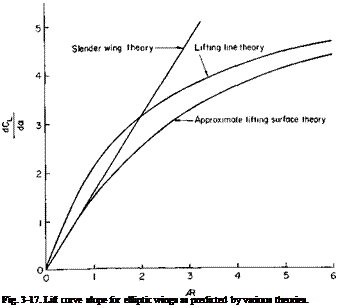Approximate Lifting Surface Theory
 |
Consider a two-dimensional, flat plate airfoil with the distributed vorticity concentrated at the one-quarter-chord point, as shown in Fig. 3-16. Suppose
the boundary condition is satisfied only at the three-quarter-chord point so that
Г
" 2b(c/2)F’ Г = ncaV,
so that
With this simple artifice, a result identical to more exact theory is obtained. Hence, if we were to concentrate the bound circulation at the one-quarter-chord line and satisfy boundary conditions only at the three – quarter-chord line, we might expect that for a finite wing the calculation of wing lift might agree closely with more exact calculations. Such is the case sometimes referred to as Weissinger’s approximation.
De Young [10] applies Weissinger’s approximation to the elliptic load distribution on a straight line and further assumes that the induced angle of attack is constant along the three-quarter-chord line and equal to the wing angle of attack a. With this assumed model, since C, is constant along
the wing, we need consider only the midspan value of the section C,. Integrating the contributions of the bound and trailing vortices at the midspan location, the result is obtained that
dCL 2nAR ~da = 2 + £AR/7c’
where E is the complete elliptic integral of the second kind with modulus к and
i – tcAR
~ Vl + (TtAR/4)2’
The above is somewhat unwieldy to use in view of the £-function. Hence Ref. 10 assumes CL of the form
2ttAR
L* “ AR + 2/(AR)’
 |
By matching the two expressions and their first derivatives with respect to
AR at AR = 0 and oo we have an easily handled expression for CLx as a function of CL :
![]() 2л AR
2л AR
Cu ~ AR + 2(AR + 4)/(AR + 2)
Equation (3-55) is offered as a first-order correction to lifting line theory for large aspect ratio wings or to slender wing theory for low aspect wings. Equations (3-37) (with a0 = 2k), (3-53), and (3-55) are compared in Fig. 3-17. Equation (3-55), considering its simplicity, agrees remarkably well with more exact results. By applying corrections to it for other than elliptical loadings from lifting line theory we can obtain a quick estimate of the lift curve slope of lifting surfaces in general.
Summary
Methods of estimating the characteristics of two- and three-dimensional airfoils have been developed in this chapter. For two-dimensional airfoils, the lift is linearly dependent on the angle of attack and on the camber ratio. A point on the airfoil, called the aerodynamic center, at which the aerodynamic moment is constant, independent of lift, was found to exist.
For finite wings the slope of the lift curve decreases with decreasing aspect ratio. When the deflection of the trailing vortex sheet is accounted for in calculating the wing lift, it was found that a given wing can develop a limited lift coefficient, irrespective of stalling. This limiting CL increases approximately linearly with aspect ratio.
Problems
1. Given an elliptic wing with a span of 40 ft and an aspect ratio of 4, the slope of the section lift curve is 0.1C,/deg. By use of suction BLC the wing is unstalled up to an angle of attack of 35°. At this angle, what is the wing CL? Account for the deflection of the trailing vortex sheet. What is the value of the midspan circulation at 150 mph at standard sea-level conditions? What is the value of CD. ?
2. Two two-dimensional airfoils are in tandem, that is, one behind the other. They are five-chord lengths apart. If each airfoil is at an angle of attack of 10° with respect to the free-stream velocity, what is the lift coefficient of each?
3. What is the critical Mach number of a thin circular arc airfoil with a 5% camber ratio at zero angle-of-attack?
4. Using an approach similar to slender wing theory, derive an expression for the lift on a cone.











